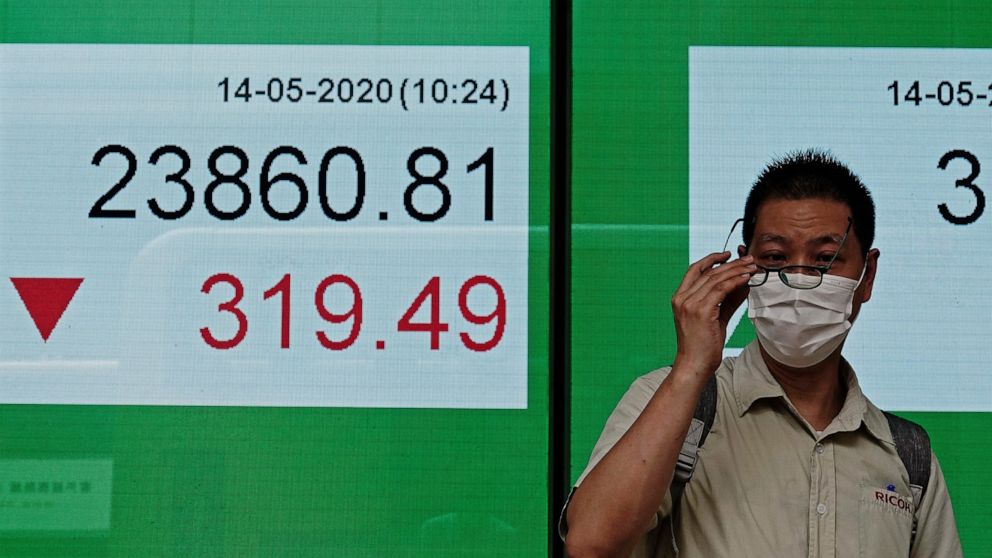Stocks zigzag on Wall Street as hope, skepticism collide
Stocks are zigzagging in another erratic day of trading on Wall Street Thursday, as hopes for a relatively quick economic recovery continue to collide with skepticism that it can happen anytime soon
By
STAN CHOE and DAMIAN J. TROISE AP Business Writers
May 14, 2020, 5:41 PM
5 min read
5 min read
NEW YORK — Stocks are zigzagging in another erratic day of trading on Wall Street Thursday, as hopes for a relatively quick economic recovery continue to collide with skepticism that it can happen anytime soon.
The S&P 500 was up 0.5%, as of 1:30 p.m. Eastern time, in a day of roller-coaster trading. After falling 1.9% shortly after the start of trading, it clawed back nearly all its losses by the late morning, only to fall again and then peek back higher. Stocks in Asia and Europe dropped to sharper losses, while Treasury yields sank in a sign of increased pessimism.
The up-and-down trading fits with Wall Street’s wavering action in recent weeks as it digests a dizzying few months.
After a 30% rally immediately followed a nearly 34% plunge earlier this year, the S&P 500 has wobbled as investors rethink bets that the reopening of economies around the world will allow for a relatively quick resumption of growth. Another possible flare-up in tensions between the world’s largest economies is also hitting markets, with comments from President Donald Trump about China further weighing on them Thursday.
The Dow Jones Industrial Average was up 226 points, or 1%, at 23,474 after pulling back from an earlier loss of 458 points The Nasdaq composite was virtually flat.
The day’s turnaround was powered by a rally for stocks that have been getting pummeled this year on worries about the economy: banks and energy companies.
Wells Fargo jumped 8.4%, part of a 2.3% rise for financial stocks overall in the S&P 500. Energy stocks were close behind with a gain of 1.4%. Through much of this year, investors have pummeled those areas of the market on worries that the recession will mean less profit for making loans and a collapse in demand for oil.
Lagging behind the market were big technology stocks, which have been the market’s strongest stalwarts for much of this this year. Microsoft slipped 1.1%, and Apple was down 0.5%.
Before the recession hit, U.S. stocks quickly lost just over a third of their value as investors anticipated an avalanche of layoffs hitting the economy. Those fears have indeed turned true, and a report on Thursday showed that nearly 3 million U.S. workers filed for unemployment benefits. That brings the total to roughly 36 million in the two months since the pandemic caused widespread orders for people to stay at home and businesses to shut down.
But stocks began climbing in late March after massive amounts of aid promised by the Federal Reserve and Capitol Hill convinced markets that the worst-case scenario of a financial crisis wouldn’t be happening. Gains accelerated on hopes that the recession, while severe, could be relatively short and that the economy could resume its growth as shutdown orders lift.
Many professional investors have warned the rally was overdone, though, given how much uncertainty exists about how long the recession will last. On Wednesday, Federal Reserve Chair Jerome Powell warned this could become a prolonged downturn, while the top infections diseases expert in the U.S. said Tuesday that reopening the economy too quickly could backfire and lead to more deaths.
Recently, worries about renewed U.S.-China tensions have also weighed on markets. A bruising trade war between the two had dragged on the global economy before the pandemic hit, and some U.S. politicians are now blaming China for not doing more to stop COVID-19 from spreading.
“I have a very good relationship,” with China’s leader, Xi Jinping, Trump said in an interview with Fox Business Network, “but I just — right now, I don’t want to speak with him. I don’t want to speak with him.”
Trump also said the government is considering barring Chinese stocks trading on U.S. exchanges unless they follow U.S. accounting rules.
The yield on the 10-year Treasury fell to 0.60% from 0.64% late Wednesday. It tends to fall when investors are downgrading their expectations for the economy and inflation.
In Europe, France’s CAC 40 lost 1.7%, and Germany’s DAX lost 2%. The FTSE 100 in London fell 2.8%. In Asia, Japan’s Nikkei 225 lost 1.7%, the Hang Seng in Hong Kong dropped 1.4% and the Kospi in South Korea slipped 0.8%.
Analysts say they expect the market to remain in a wait-and-see approach for weeks as investors gauge how economic reopenings underway are going. Investors want to see if second waves of coronavirus infections occur if governments lift their restrictions on businesses too soon.
A barrel of U.S. crude oil for delivery in June rose 6.7% to $26.98 per barrel. Brent crude, the international standard, added 5.7% to $30.84 per barrel.
———
AP Business Writer Yuri Kageyama contributed.
![]()


